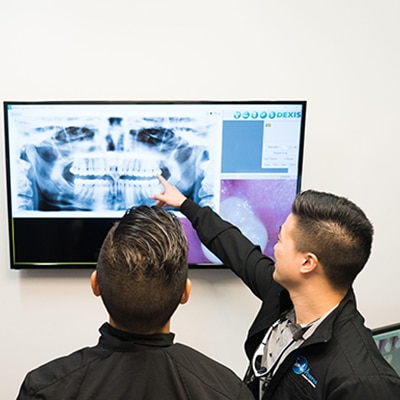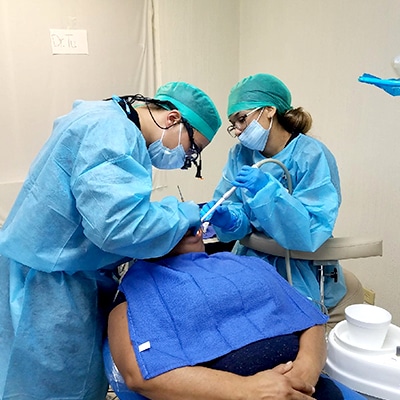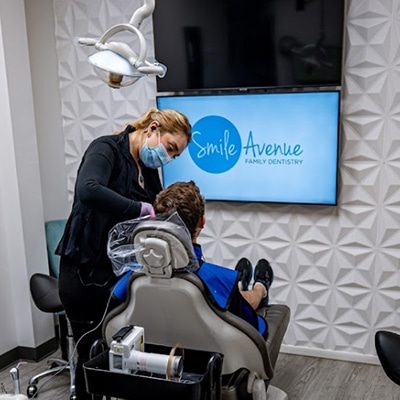
Third molars are also called wisdom teeth because they are the last set of adult teeth to appear in the mouth. Typically appearing between the ages of 17 and 21, many individuals face challenges due to insufficient space for these wisdom teeth, necessitating their removal. After wisdom teeth extraction surgery, most patients recover in 3–4 days, although complete recovery could take up to 7 days. If the extraction of an impacted wisdom tooth is complex and causes problems, the recovery period could be extended to around two weeks.
In the US, around 5 million people have their wisdom teeth extracted annually. Over 85% of individuals have their wisdom teeth extracted at some point in their lives.
What are wisdom teeth?
The wisdom teeth, or back teeth, erupt in your mouth last and farthest back, typically in your late teens or early 20s. This phase of mouth growth is typical. Two wisdom teeth in the upper jaw and two in the lower jaw make up the average set of four, although some people have more, fewer, or even none at all.
While some wisdom teeth pass through easily, some present challenges that may require extraction or other care.
How painful is wisdom teeth removal?
Wisdom tooth extraction in Katy, TX, involved removing one or more of the third molars. After wisdom teeth surgery, most patients have minor soreness, mild pain, and swelling for roughly three days. In three to seven days, you should feel better, unless you get a dry socket.
How long should you take off work?
Generally, your dentist will recommend requesting 1-2 days off for recovery after wisdom teeth removal. It’s crucial to adhere to the advice of your surgeon and dentist in addition to supporting quick healing by doing a few simple things.
Day of Surgery: What to Expect
Oral surgery for wisdom tooth extraction is typically an outpatient procedure that usually lasts 45 minutes or less. There is no overnight stay required. If you are receiving only local anesthesia, which is common for non-impacted wisdom teeth, you can drive to and from the appointment. However, for surgical extractions with moderate to deep sedation, you will need transportation to and from your oral surgeon’s office.
The choice of anesthesia options may influence the initial day of recovery. Local anesthetic and conscious sedation tend to be less demanding on the body compared to deep sedation.
Waking Up
For a simple wisdom tooth extraction, a local numbing agent and light sedation may be administered. You are likely to be partially unaware during the procedure but can typically leave soon after the extraction is complete.
Wisdom tooth extraction is necessary when they have not erupted through the gums and may be embedded in the jawbone. During this procedure, the patient typically receives some form of general anesthesia in addition to local anesthesia near the extraction site.
After an impacted wisdom tooth surgery, it may take a longer time for you to wake up from general anesthesia. You are unlikely to remember anything about the procedure, being moved to a recovery room, or the few minutes before the procedure began.
Going Home
When you awaken after the surgery, you may observe numbness in your mouth, and the sensation will gradually return over the next several hours.
During the initial 24 hours of recovery, there may be some blood in your mouth.
It is advisable to plan for rest on the evening of your surgery and to cancel any strenuous activities.
For impacted wisdom teeth surgery, you’ll have additional steps to follow on the day of the surgery:
- Your surgeon will provide a gauze pad to be kept over the extraction site for a period ranging from 30 minutes to 4 hours. Additional gauze pads may be given for use over the next few hours. Change gauze pads every hour, following the duration recommended by your dentist.
- Your surgeon may advise you to fill prescriptions for painkillers or antibiotics on your way home to begin taking them promptly.
- If over-the-counter painkillers are suggested instead of prescriptions, you’ll likely be instructed to take them upon arriving home.
- Commence using an ice pack soon after surgery on the side(s) of your jaw where teeth were extracted.
Nausea and vomiting may occur within the first 10 hours after surgery due to swallowed blood, sedation, or general anesthesia. If vomiting persists beyond this time frame, it’s essential to contact your surgeon.
Wisdom Teeth Home Care: Do’s and Don’ts
After the completion of wisdom teeth surgery, your dentist or oral surgeon will provide guidelines on caring for your mouth during the recovery period.
For a swift recovery, adhere to these simple guidelines:
Do…
- Take the prescribed pain medications as soon as possible after surgery.
- Change your gauze once every hour.
- Remove your gauze pad(s) 2-3 hours after surgery concludes or as per your surgeon’s instructions.
- After surgery, apply an ice pack for 24 to 36 hours.
- Apply moist heat as needed to alleviate jaw soreness after the initial 36 hours.
- Consume only soft foods.
- Drink plenty of fluids, including water, to stay hydrated.
- Utilize a wedge pillow to elevate your head.
- Begin brushing your teeth, excluding the extraction site(s), starting on day 2.
Don’t…
- After 24 hours, you can brush your teeth, floss, or use mouthwash.
- Touch the area around the extraction site(s).
- Remove your gauze to inspect the extraction site except when replacing it.
- Rinse your mouth vigorously for any reason.
- Drink from a straw for the first 3 days.
- Spit.
- Smoke (for at least 5-7 days).
- Engage in strenuous activities for at least 3-4 days (exercise, housework, hiking, etc.).
- Consume alcohol.
- For 48 hours, drive a vehicle or operate heavy machinery.
- Consume excessive sugar, as it may impede healing.
- Eat hard, sticky, or crunchy foods.
- Use more pain medication than necessary (consider using a pill cutter to adjust the dosage size).
Tips for Fast Wisdom Teeth Removal Recovery
To expedite the recovery process after wisdom teeth extraction, it’s crucial to adhere to your surgeon’s instructions.
It is normal to experience some pain, swelling, and discomfort following the extraction of your wisdom teeth. For a prompt healing process, consider these tips:
- Prevent dry sockets.
- For the first 3 days, keep your head elevated
- Keep your cheek(s) iced for 36 hours after surgery
- Rinse with warm salt water
- Reduce inflammation
- Don’t let your mouth dry out
- Massage your jaw
- Try photobiomodulation
- Drink coconut water
- Rest as much as you can
- Eat healthy soft foods
- Don’t overuse medications
1. Prevent dry socket
The paramount factor in expediting wisdom teeth recovery is to take all necessary precautions to prevent a dry socket.
A dry socket occurs when the blood clot covering the extraction site becomes dislodged, a complication observed in up to 25-30% of impacted wisdom teeth removals. The displacement of this blood clot can lead to significant pain by exposing the underlying bone, most commonly occurring on days 2-3 after tooth extractions.
Your dentist or oral/maxillofacial surgeon should provide a set of post-surgery home-care instructions, adherence to which is crucial in preventing a dry socket.
Effective measures to prevent a dry socket include:
- Avoid soaking new gauze pads in water before placing them on the extraction site.
- Steering clear of drinking through a straw, smoking, or any sucking action.
- Refraining from vigorous rinsing.
- Not removing the gauze until ready to replace it.
- Utilizing resorbable sutures.
- Engaging in light coconut oil pulling each evening for the week after surgery.
- Consuming soft and/or liquid foods, avoiding hard, spicy, or very hot options.
- Taking prescribed antibiotics before and/or after surgery.
- Avoiding passionate kissing.
- Considering the timing of wisdom teeth surgery during days 23-28 of your cycle if taking estrogen-based birth control, may elevate the risk of a dry socket.
A dry socket may heighten the risk of infection, necessitating close communication with your dentist. Post-operative infections can manifest several weeks after surgery, influenced by your dentist’s protocols. With extensive experience in extractions, instances of dry sockets are rare, emphasizing the importance of discussing extraction methods with your dentist beforehand to minimize the risk.
2. Keep your head elevated for the first 3 days
Use pillows or a wedge pillow to prop your head up while you sleep so that your upper body is at a 45-degree angle.
Because sleeping flat increases blood vessel tone and blood volume near the site, which might cause the wound to throb, doing this can help you recover after wisdom teeth surgery more quickly. Furthermore, keeping your head higher than your feet can aid in the reduction of swelling.
When you’re standing up, using a travel pillow is a simple and efficient way to keep your head pleasantly raised.
3. Ice your cheek(s) for the first 36 hours
After the extraction of wisdom teeth, apply an ice pack to the cheeks on the side(s) where your wisdom teeth were removed. Ice for 20 minutes, then take a break for 20 minutes, repeating this cycle as much as possible during the initial 36 hours after surgery.
Consistent use of cold compresses can effectively reduce swelling and inflammation even before visible signs appear. By adhering to a regular icing routine for the first day and a half, you may alleviate pain and swelling throughout the remainder of your recovery.
For a hands-free icing solution, you can opt for a head wrap ice pack, especially beneficial if you underwent extractions on both sides of your mouth.
However, exercise caution and avoid applying heat to this area until around day 3, as heat can increase blood flow, potentially intensifying pain and swelling.
4. Rinse with warm salt water
To maintain cleanliness in the wound area, delicately rinse your mouth with warm salt water a few times each day.
For optimal results, I recommend using a super-saturated salt water rinse. This not only helps prevent debris and bacterial buildup at the surgical site but may also contribute to reducing gum inflammation.
To prepare a super-saturated salt water rinse for your healing extraction site:
- Pour 8 ounces of warm water (not hot or boiling).
- Gradually stir in Celtic sea salt or pink Himalayan salt, one tablespoon at a time, until it stops dissolving.
- Very gently swish the solution around in your mouth.
- Do not spit; instead, hold your head over the sink and let the water fall out.
- Repeat this process 2-3 times per day for optimal care.
5. Reduce inflammation
According to Dr. Patrick Vuong, DMD: Effectively managing inflammation following a wisdom tooth extraction is crucial for pain control. Since inflammation peaks after 48 hours, it is essential to consistently take anti-inflammatories through day 2, even if you experience immediate relief after the extraction.
Ibuprofen and acetaminophen can be used in combination, as they target inflammation through distinct pathways. Additionally, BCQ supplements, consisting of bromelain, curcumin, and quercetin, serve as valuable additions to reduce inflammation.
6. Don’t let your mouth dry out
After wisdom tooth surgery, you may experience considerable soreness in your mouth. While you might feel inclined to breathe through your mouth due to tenderness, it’s advisable to avoid it as it can lead to dryness.
Mouth dryness has the potential to disrupt the pH balance, creating an environment where cavity-causing bacteria can thrive, thereby increasing the risk of infection.
If breathing through your mouth is unavoidable, consider using an oral cavity moisturizer such as Biotene gel to support the health of your mouth during the recovery period.
7. Massage your jaw
During wisdom tooth surgery, the prolonged wide opening of your mouth can contribute to myofascial pain and strained muscles, a condition known as temporary trismus or ‘lockjaw.’
The masseter muscle, crucial for chewing, is particularly susceptible to soreness.
Post-surgery, massaging this area aids in faster recovery by releasing unnecessary tension held in the jaw.
To massage your masseter muscle:
- Position your first two fingers just before the opening of each ear.
- Gently massage with your first two fingers in circular motions.
- Avoid excessive massage.
Jaw stiffness following the wisdom tooth extraction is expected to significantly decrease after 7 days and is typically resolved by about the 11th day post-surgery.
8. Try photobiomodulation
Photobiomodulation has the potential to significantly diminish pain, swelling, and trismus (jaw pain) following wisdom tooth surgery. However, for this light therapy to be effective, your dentist or surgeon must administer it immediately after the extraction procedure.
A 2015 study conducted by oral/maxillofacial surgeons involved the application of red light and near-infrared light around the surgical sites immediately after extracting wisdom teeth for a group of patients. The results were compared with a control group that did not receive this therapy.
The patients who underwent photobiomodulation therapy demonstrated ‘significant reductions in pain, swelling, and trismus at 48 hours and 7 days postoperatively.’
There is some indication that applying light therapy externally to the jaw, rather than internally, may further enhance the reduction of trismus.
This technique is also known by various terms such as red light therapy, near-infrared therapy, or low-level light laser therapy (LLLT).
9. Drink coconut water
Coconut water serves as a hydrating and nourishing option for your body, offering soothing relief to inflamed gums during the healing process post-surgery.
Its ability to maintain stable blood sugar levels and replenish electrolytes becomes particularly beneficial when solid foods are not an option during the recovery from wisdom teeth surgery. This balance allows the body to prioritize healing.
Moreover, there is evidence supporting the anti-inflammatory properties of coconut water, contributing to an expedited healing process. To enhance its effectiveness, Dr. Patrick Vuong, DMD recommends consuming it ice cold.
For those who prefer a different approach to consuming coconut water, consider incorporating it into a smoothie with ample greens and healthy fats, using coconut water as the liquid. Adding a dash or two of turmeric can further combat inflammation and promote a speedy recovery.
10. Rest as much as you can
It may be challenging to relax or enter a deep slumber due to discomfort from healing extraction sites. Nonetheless, your body will have a higher chance of mending quickly the more rest you can get.
11. Don’t overuse medications
Medications such as hydrocodone (Vicodin) and sedatives commonly administered during wisdom tooth surgery can often result in side effects like nausea and vomiting. Vomiting, in particular, may heighten the risk of infection, potentially impeding the healing process.
Furthermore, there is a recognized association between opioid abuse and prescriptions obtained from dental procedures.
To minimize the risk of vomiting post-surgery, consider hydrating with water, coconut water, and possibly unsweetened green tea.
After approximately 10 hours post-surgery, any nausea induced by swallowing blood or surgical anesthetics should subside, especially for individuals who have a light intake of food or drink during the NPO (nothing by mouth) period before surgery.
It is advisable to use pain medication sparingly, utilizing a pill cutter if needed to reduce pill size. Proper disposal of any remaining medication is crucial, and it should not be left unattended in the house once it is no longer required.
How long does it take to recover from wisdom teeth removal?
Most individuals experience recovery from wisdom teeth removal within 3-4 days, although, for impacted wisdom teeth, the recovery period may extend to 1 week. Swelling and bruising can persist for up to 2 weeks.
Here’s a timeline outlining the standard healing process after the extraction of impacted wisdom teeth:
- First 24 hours: Blood clots form and the effects of numbing agents wear off, leading to the onset of pain and swelling. Lethargy and nausea are common.
- Days 2-3: Swelling begins to subside, and pain usually starts to diminish. The risk of dry sockets is highest during this period.
- Days 4-7: Severe pain should alleviate, jaw stiffness may occur, and swelling continues to decrease. Bruises may appear, and the risk of dry sockets decreases significantly. Normal activities can be resumed, and return to work is feasible around day 4. Stitches, if used, can be removed around day 7.
- Days 8-10: Soreness and jaw stiffness should diminish.
- Days 11-14: Brushing sensitivity should fade.
- Weeks 3-4: Wisdom tooth sockets typically close.
- Months 3-6: Complete healing of the surgical site and surrounding areas is expected.
Recovery times may vary, particularly in cases where a dry socket develops or if the wound becomes infected.
When to Call Your Dentist
If you encounter any of the following symptoms following wisdom teeth surgery, it is imperative to promptly contact your dentist or surgeon:
- Excessive bleeding persists beyond 4 hours post-extraction.
- Throbbing pain that does not alleviate with medication.
- Pus drainage.
- Progressive increase in swelling.
- Presence of fever and chills.
- A sharp increase in pain 48 hours after the extraction.
- Persistent nausea or vomiting, especially beyond the initial 10 hours post-surgery.
- Vomiting substantial amounts of blood.
- Coughing.
- Chest pain.
- Shortness of breath.
- Difficulty swallowing or breathing.
- Blood or pus discharge from your nose.
What to Eat After Wisdom Teeth Removal
After your surgery, you should only consume liquids and very soft meals, such as mashed potatoes or applesauce, for the first 24 hours. Steer clear of items with sharp edges, high heat, or spice (such as sourdough bread).
You can begin to eat a wider range of foods between days 2-3. Even if you might not be really hungry, it’s still necessary to consume a lot of calories and nutrients. Make your preparations in advance for a simple meal.
How long after wisdom teeth removal can you eat normally?
You should be able to resume your normal diet four days after having your wisdom teeth out, barring any complications such as an infection or dry socket.
For a comprehensive shopping list and information on the best foods to promote quick recovery, download my free guide on what to eat after oral surgery.
I advise consuming a lot of foods high in vitamin D3 and K2 following wisdom tooth extraction. These minerals promote the formation of bones, together with calcium and vitamin A.
Should you be unable to consume foods high in K2 and/or D3, you have the option to take both vitamins as supplements.
How to Manage Pain During Recovery
Following wisdom teeth extraction recuperation, the following medications are commonly prescribed:
- Hydrocodone (Vicodin)
- Tylenol with codeine (Tylenol 3)
- Ibuprofen (Advil)
- Acetaminophen (Tylenol/Paracetamol)
Ibuprofen and hydrocodone are the best painkillers for wisdom teeth surgery discomfort. Tylenol appears to be less successful in relieving dental pain.
How long should you take painkillers after wisdom tooth extraction?
The majority of patients can stop taking prescription medications two to three days following extraction without any issues. To manage your discomfort for the next three to four days, you might need to take over-the-counter medications.
How to Sleep After Wisdom Teeth Removal
Getting restful sleep after wisdom teeth removal can be challenging, especially during the initial 2-3 nights. To promote optimal sleep:
- Keep your head elevated using a wedge pillow for the first 5 nights; avoid lying flat.
- Apply ice to your cheeks right before bedtime for the first 36 hours.
- Refrain from leaving gauze on the surgical site when going to sleep.
- Avoid sleeping on your side, as this can contribute to increased swelling on the side of your face resting on the pillow.
Complications that Extend Recovery Time
If complications arise after wisdom teeth surgery, the healing process may be prolonged, as the body needs to address not only the healing of the open tooth socket but also any subsequent issues that may arise.
The most common complications associated with wisdom teeth surgery include:
1. Paresthesia: Nerve damage caused by inadvertent injury during the procedure may result in temporary or permanent numbness (pins and needles) in the tongue, lips, and/or cheeks. Paresthesia affects varying percentages of patients, ranging from 0.7% to 22%, depending on the study. In most cases, it resolves without treatment, but approximately 1.1% may experience permanent paresthesia.
2. Dry socket: The loss of the blood clot in the tooth socket, known as a dry socket, exposes the bone and can lead to intense pain. Up to 30% of wisdom teeth surgery cases may result in a dry socket, with a healing time of about 7-10 days.
3. Infection: Secondary infections may necessitate additional visits to the dentist. Some infections manifest weeks after surgery, and although rare, they can pose a risk to one’s health. The likelihood of infection is higher in lower (mandible) wisdom teeth, with inexperienced surgeons, in the presence of a dry socket, after food impaction, or in cases with a deep tooth socket.









